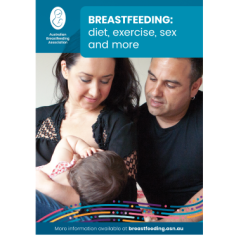Wondering how breastfeeding affects fertility?
For some it does, for others it doesn’t.

Whether you're planning for another baby, or hoping to avoid pregnancy, you'll find all the information you need about breastfeeding and your fertility here.
How does breastfeeding affect fertility?
Women who aren't breastfeeding may ovulate (release an egg) as early as 5 to 6 weeks after the birth. However, if you’re breastfeeding, your hormones don't return to pre-pregnancy levels until much later, and this delays ovulation and the return of periods.
Breastfeeding mums start menstruating again at different times after giving birth. For some it takes months, for others it can take years. It can depend on your baby’s breastfeeding pattern and on the sensitivity of your body to breastfeeding hormones.
The return of periods can happen when:
-
your baby starts to breastfeed less or for shorter times, especially if this is sudden
-
you start offering formula top-ups
-
your baby starts sleeping for longer or sleeping through the night
-
your baby starts solids.
When your periods do return, they may not be regular at first. Compared with other mothers, breastfeeding women whose periods have returned have fewer regular cycles. They are also less likely to get pregnant in the first year after their baby's birth.
Any change in your vaginal mucus or any bleeding may be a sign of a change in your hormone levels and a return to being fertile. Unless you know your signs of ovulation very well, you probably won’t know for sure that you are fertile again until you have your first period after giving birth.
Do I have to stop breastfeeding to get pregnant?
The answer is ‘possibly’. If your periods have returned and you are ovulating, your fertility levels may be high enough to get pregnant and weaning will not usually help any further. You can check if you are ovulating with a temperature chart, the Billings Method of cervical mucus changes and/or a home ovulation test kit.
If you have problems ovulating, or the second half of your menstrual cycle is not long enough to begin a pregnancy, you may need to wean your child for the best chances of success. Women whose periods don’t return until they have fully weaned their babies may also need to wean to allow ovulation to occur.
If you will need to use IVF treatment it can be a difficult decision whether to wean your child to try again. Parents seem to approach this in two different ways. Some decide they will do anything that might improve their chances of success. This includes weaning. If it doesn’t work, they will know that they did everything possible and not be left to wonder if breastfeeding was stopping pregnancy. Other parents may decide to wait until their child weans. This avoids the stress of weaning early but there is a risk that treatment may not work.
Birth control choices
Most couples start thinking about birth control soon after their baby’s birth. Breastfeeding women have a number of choices. All forms of contraception reduce your chances of getting pregnant but none will protect 100 percent. Before you decide about a method of birth control, talk to your doctor or your state family planning organisation.

The Lactational Amenorrhea Method, known as LAM
LAM is listed by the World Health Organization as an accepted and effective method of contraception. Studies have shown that LAM is a 98% effective method of contraception for as long as you meet ALL of the following conditions:
-
Your periods have not returned.
-
AND your baby is less than 6 months of age.
-
AND you are exclusively (fully) breastfeeding (your baby is having no other foods or drinks).
Therefore, while your young baby continues to breastfeed frequently, you may not get pregnant.
Non-hormonal birth control methods
These can be a good choice after having a baby as they are safe to use when breastfeeding.
With condoms, you may need to use a water-based lubricant if your vagina is dry or if the latex makes you sore. Other methods include the copper intrauterine device (IUD), a diaphragm or an ovulation awareness method (such as the Billings Method).
Hormonal birth control methods
-
Progesterone-only methods (minipill, progestogen-containing IUD, injections and implants) are the most common hormonal methods used by breastfeeding women. Some women still find their milk supply drops, especially if they start the method while their baby is still very young. Feeding the baby more often for a while can sometimes fix this. However, some mothers find that their milk supply doesn’t return to normal until they change to a non-hormonal form of birth control.
-
Combined contraceptive pill may be used after 6 weeks only. Some breastfeeding women have found their milk supply still reduces after this time.
-
Emergency contraception doesn't usually have any effect on breastfeeding. Emergency contraception can be taken up to 72 hours after sex.
Talk to your doctor or pharmacist if you have questions about the safety or suitability of different hormonal birth control options while breastfeeding. You can also call a medicines information line for advice.
The information on this website does not replace advice from your healthcare provider.
© Australian Breastfeeding Association April 2022
Evidence-led info and practical tips from our Parenting Information Series
Breastfeeding: diet, sex, exercise and more



